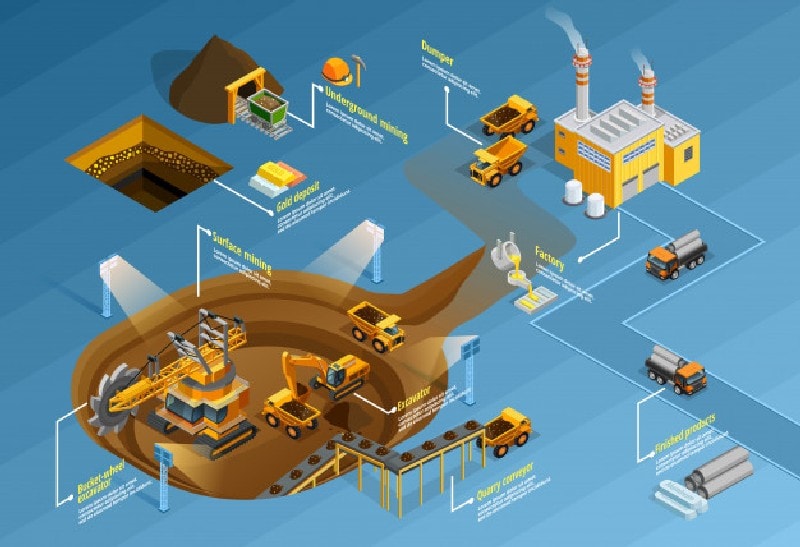The today’s word (filled with loads of industrial, technical, urban, rural, economic and scientific advancements) that we see now is the result of the industrial revolution of the 18th century. Before this, human labor was primarily associated with the soil.
Then the industrial revolution took place and channelized economic advancements and industrial innovations around the world.
Beginning in Great Britain and spreading all over the world, including the United States, the Industrial Revolution was primarily owing to the introductions and innovations in machinery and its technologies.
The emergence of these technologies resulted in augmented productivity and impacted various societies immensely.
Have you ever wondered how the Industrial Revolution catalyzed global change?
Quick Statistics: By the end of the 18th century, Britain’s urban population had increased by over 30%, driven largely by the Industrial Revolution and urbanization processes. According to historical data from the British Census, between 1801 and 1901, London’s population alone surged from about 1 million to over 6.5 million, showcasing the dramatic demographic shifts propelled by industrial advancement.
Inspirational Quotes from Marketing Leaders: As renowned economist John Kay once stated, “The Industrial Revolution was simply the biggest event in the history of the world since the invention of agriculture and the domestication of animals.” This quote underlines the profound and enduring impact the revolution had in reshaping societies, economies, and technologies globally, laying the groundwork for modern marketing practices.
All in all, the Industrial Revolution get involved with everything in society.
The entire social sphere in Great Britain changed due to urbanization as well as the treatment of the working class. Moreover, while the technology and the production evolved, the entire economic environment of the goods changed as well.
In this post, we will be talking about some of the main causes of the Industrial Revolution and understand their key roles in the process-
Table of Contents
The Major Causes of the Industrial Revolution Include
1) Capitalism
This was an essential component leading to the rise of industrialization.
The standard form of the same during the revolution is known as laissez-faire capitalism. This translates to “leave us alone,” wherein the government was asked to stay out of the economy and allow the people to carry out their economic activities.
At the time, the economic system which followed was mercantilism. This system favored the government and allowed them to control all aspects of the economy.
As capitalism required more work as well as investment from the people instead of the government, it is one of the critical factors leading to the Industrial Revolution.
For instance, in Britain, it was the wealthy entrepreneurs who invested and set up factories as well as mines. These moves were backed with the motive of profits, which originated due to capitalism.
2) European Imperialism | Causes Of The Industrial Revolution
By the mid-18th century, many European states were rising in colonial powers.
Their next focus was on having authority globally. Britain had only a small part of the population in France and Spain. Thus, it had been fighting against these powerful and more significant states always.
It put a lot of pressure on the country to produce less labor-intensive products. This was a crucial part of the revolution.
European Imperialism had a crucial role in the revolution; first, it had access to a large number of raw materials, which could then be used to produce goods.
This was because the European countries had a reach in North as well as South America from where they could get their resources. Thus, European Imperialism could provide the funds which were necessary for the production of goods.
Second, it also created a substantial market for products. The countries had well-established trade routes. Thus, they could sell the products they manufactured around the world.
3) Mining of Resources
Resources, including coal and iron, were vital to the Industrial Revolution.
Britain had vast reserves of these, thereby, aiding to the growth of industries and factories.
Moreover, with the invention of coal-powered steam engines, the increased demand for coal resulted in the improvement of the techniques used for the mining of coal.
Coal was also required for other means of transportation and smelting of iron ores, among other activities.
Furthermore, with the rising efforts to refine iron and thereby, reducing its cost, England managed to reduce its dependency on Northern Europe for iron.
It also ended up becoming the biggest iron industry globally.
They used their iron in several industries, such as railroads, steam engines, textile inventions, tools, construction, and shipbuilding.
4) Impact of the Steam Power on the Revolution | Causes Of The Industrial Revolution
The steam engine was used to power various industries across Britain, such as cotton mills, distilleries, flour, waterworks, paper, ironworks, and canals.
Just like how steam engines required coal, steam power made way for miners to go even deeper, and thus, extract a larger quantity of the energy source.
During the Industrial Revolution, the demand for coal rose tremendously.
Not only were the factories requiring it to manufacture different goods, steamships, as well as railroads, also needed coal to transport the goods and raw materials.
5) Agricultural Revolution
Britain Agricultural Revolution talks about the tremendous growth of the agricultural sector of Britain from the 17th to the mid-19th century.
The methods of intensive farming were revolutionized, including selective breeding as well as heavy manuring, crop rotation, enclosed fields, and the improved versions of Chinese Ploughing.
The Agricultural Revolution also included an increase in land ownership. This further augmented the population of the country. This is why the workforce in mines and factories increased.
As the methods of farming got better, and farmers started using machinery in the farms as well, the food production grew. Owing to the use of machinery; the same work could be done with a reduced workforce as well.
This allowed people to shift from farms to mines and factories, and thus, cities and towns grew.
Another push was the Enclosure Movement. Here, owing to the increase in private ownership of lands, such as farms, small farmers could not gain control over their lands.
Thus, as they lost their traditional lands, they migrated to towns and cities in search of wages. Factory and mine owners could then exploit the large workforce. Hence, the Agricultural Revolution was an important cause of the Industrial Revolution.
6) Scientific Revolution
There is a conflict among historians regarding the period of the Scientific Revolution.
Some believe it was during the times of Nicolaus Copernicus, 1473 to 1543, while some believe it was during the times of Isaac Newton, 1642 to 1727.
The revolution happened in European countries.
It refers to developments in the cultural, conceptual, institutional as well as social constructs related to belief, knowledge, and nature.
As Europe became more accepting of scientific ideas, the road for creation and development of ideas and innovations became wider.
7) Governmental Policies
Britain was typically a constitutional monarchy during the 18th century.
It was much more stable as compared to Spain and France. There were better policies in practice. Moreover, the government gave patents and exclusive rights to inventors for control over their innovations for a specific number of years.
This helped with the financing of innovative ideas as well.
Capitalism was further encouraged through the enclosure system (discussed earlier under Agricultural Revolution). As the private ownership of farmlands was allowed, the industrial class formed easily.
Another significant policy in place was allowing incoming immigrants. This helped in enhancing the development as well as the skills of various industries. This further led to the weakening of the guilds. These policies helped Britain develop rapidly during the Industrial Revolution as compared to other European countries.
8) Political Influence
Britain, by the mid-18th century, also had immense power overseas.
Owing to the victories in the battles of Buxar and Plassey, Britain had a significant political influence over India.
India was the manufacturing hub for cotton across the world. Britain especially had control over Bengal, which was the trade hub. Through control over India and its cotton industry, cotton spinning machines were invested in Britain.
Various resources of India, including mineral, human, agricultural, and natural, formed a solid foundation for Britain. This helped Britain further become a global power.
9) Technological Innovations
One of the major factors which helped the Industrial Revolution succeed was the advancement in technology.
In terms of the textile industry, Britain could not grow cotton themselves owing to their cold climate and lack of manpower, which could meet the demand. It was only known for its woolen industry.
However, after having control over India’s cotton industry, Britain could start gaining power.
The innovations in the weaving techniques finally helped push the growth of Britain’s textile industry. In 1733, James Kay improved the traditional handloom and introduced a simple flying shuttle.
This doubled the productivity of its previous version. In 1764, James Hargreaves invented the Spinning Jenny, which solved the challenge of developing a mechanical device that simplified and automated the process of pulling and twisting of the cotton fibers, which then resulted in a strong thread. This helped increase productivity eightfold.
In 1769, with the invention of the water frame, an entire factory could complete the process of manufacturing a finished cloth from its raw material at a single point. The water wheel was an improvisation of the Jenny with a water wheel and was introduced by Richard Arkwright.
Another defining invention in the Industrial Revolution was the steam engine. It also powered the textile industry of Britain along with numerous others. It allowed industries to reduce their dependence on water. It also facilitated the easy transportation of goods.
10) Growth in Population
As discussed earlier in the article, in the early 1700, Britain had a small population. It was very small compared to the population of France, India, and China, which were leading economies at the time.
As to the lack of workforce, there was an increased need to develop and produce machines that required lesser human intervention.
The Agricultural Revolution helped the population growth as it helped provide enough food to feed everyone. This led to Britain eventually having enough population and, thus, enough labor to augment its industrial growth.
11) Financial Innovations
Since the early 18th century, Britain has sturdy financial institutions in place. These included central and country banks.
It also had a stock exchange which helped finance new ventures. Britain could enjoy profits since the 1760s owing to the rise in its economic, commercial as well as political influence in the world. The growth in cotton and the trade industries made way for more wealth.
Moreover, with capitalism, the need for financial institutions grew. It also created a plethora of opportunities for new investments and growth.
Specialist banks, i.e., banks having industry-specific knowledge or even for areas, also grew in number. Financial institutions made their profits by keeping cash reserves and lending money and applying interests on their return.
Early users of the banks were entrepreneurs who were investors, capitalists, merchants, sales associates, financiers, and capitalists. The businesses were primarily small and individually based. Over time, joint-stock companies and shareholders emerged, and with which the future of the way businesses run has changed.
12) Transportation
Britain’s transportation systems were quite rudimentary until the early 18th century.
As the economy was flourishing, there was an increased need for developing the roads. In the 1750s, a group of people who took care of the streets, called the Turnpike trusts, emerged. They took a toll in return for their services.
However, soon after the government took control. Afterward, the canal systems were built and soon gained popularity owing to their reliability and economic features.
Furthermore, with the invention of steam engines as well as the technologies related to the iron, the transportation industry grew significantly.
The challenges about the transportation industry, which until then were hampering the Industrial Revolution, were finally overcome with the emergence of the technologies mentioned above.
13) Communication
In the latter side of the Industrial Revolution, communication methods played a key role in changing the world around the globe.
William Cooke and Charles Wheatstone, two British inventors, invented the very first commercial telegraphy system.
Also, Samuel Morse and many other inventors channelized the industrial revolution in the USA.
Different systems for railroad signaling were created by Wheatstone and Cooke that ensured a sophisticated mean for the train communications.
14) Banking
Various advancements in Banking Systems along with industrial financiers also were quite prominent for the industrial revolution on the global front.
In the 1770s, London welcomed its first Stock Exchange, and in the 1790s, the New York Stock Exchange established.
Adam Smith, a Scottish Social Philosopher, published Wealth of Nations in 1776, in which he spoke about an economic system with free enterprise alongside a lack of government interference and the private ownership of means of production.
Wrapping it up!
In conclusion, the causes which resulted in a full-fledged Industrial Revolution were many, some big and some small.
Each had their role to play and was of significant importance.
The emergence of capitalism as a theory which helped the economic power shift and starts several businesses was considered as a significant factor concerning the Industrial Revolution.
Secondly, European imperialism and its expansion across the globe, and thus, the proliferation of raw materials as well as large markets, was another significant factor.
Third, the Agricultural Revolution, which fed the increasing population, further, helped the Industrial Revolution grow along with the economies.
It led to a tremendous increase in the production of food as well as the population throughout European societies, especially Britain. This further resulted in the expansion of the workforce for use within mines and factories.
Lastly, the innovations in technology helped the workers, as well as the farmers, yield better results. Transportation, as well as communication, was improved with a significant reduction in the time taken for the entire process.
Everything picked up the pace with improvement and the emergence of innovative technologies. The presence of beneficial governmental policies further boosted the rise of technology and even motivated people by providing them with patents over their ideas.
There was a new culture of dedicated, hard-working as well as risk-taking cultivated in the Industrial Revolution. This further help cities and towns flourish under the revolution.
So, this was all about the industrial revolution that played a pivotal role in changing the world in the last three centuries.
How important do you consider the industrial revolution in improving our lives and channelizing innovations on the global front? Did we miss any of the causes of the Industrial Revolution? Update us with your views in the comment section below.






